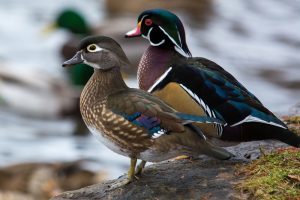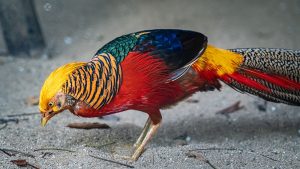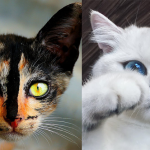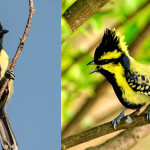With training, they can make fine pets. Since they’re affectionate birds that love to play, give them adequate space and they’ll be at home. But beware that in groups they can be super-noisy, and are still capable of taking a powerful bite out of you despite proper training and care.
Unlike other parrots in the macaw family, they’re not prolific imitators of speech.
3. Wood Duck

Wood ducks stand out as one of the prettiest water birds the world over. They’re mostly found along streams and swampy marshes all across the United States and Canada.
The male wood ducks are more stunning than their female counterparts. Males have a metallic green head and crest with tints of purple attractively sprinkled. Their necks are decorated with beautiful tapering white stripes.
Wood duck plumage is an intriguing mix of black and blue patterns and also plays the double role of attracting females when breeding. A white underbelly and a crimson-colored chest area complete the beauty of a male wood duck.
The female wood duck isn’t as stunning and features a brownish head with the belly being whitish. The chest area is splattered with white coloration.
Woefully ill-equipped to burrow out their own holes for nesting, you’ll often find these unique birds making their abode within manmade structures. They make for a thrilling but easy target for budding birdwatchers!
4. Keel-billed Toucan

What will strike you first about the Keel-billed toucan is its phenomenal bill, measuring up to a staggering 7 inches! The giant multicolored bill has also earned the keel-billed toucan another name, the “rainbow-billed toucan”, with a fusion of red, green, and yellow pigmentation.
The size of the bill can be fairly deceptive as to its weight. Although it seems heavy, it’s light and hollow. They use these colorful beaks to lure females particularly in the breeding season and also for self-defense.
These beautiful birds have plumage that’s predominantly black, with brilliant yellow feathers in the neck and breast area. Their face is an intricate blend of green and yellow. The bright red under feathers in the tail region completes its distinctive but elegant look.
Birdwatchers looking for these birds should head to the tropical and subtropical rainforests of South and Central America. Venezuela, Colombia, and southern Mexico are the ideal places to spot the keel-billed toucan. The birds can also be more easily sighted at dawn and dusk when they’re most active.
The keel-billed toucan has heavy wings making it a poor flyer. They manage short distances, often hopping from tree-branch to tree-branch within the forest. As they are social birds, you’ll see them moving in small flocks of between six and twelve birds. These groups may at times swell up to thirty birds.
They mostly inhabit holes that occur naturally in the wild or those dug out on trees by woodpeckers. They make loud frog-like calls. Their diet ranges from insects, fruit trees, lizards, to eggs.
5. Blue Jay

Blue jays offer beauty with brains, as they are considered amongst the most intelligent birds in the world. It’s easy to spot them by their distinctive “jay jay” sounding calls. Blue jays have a colorful plumage that consists of a clever combination of blue, black, and white.
Being intelligent birds, they can mimic the call of other birds. For instance, they can imitate the sounds of hawks to trick other birds. In captivity as pets, they’ve been noted to imitate human speech and even the sounds of other pets. They can be cunning to the extent of stealing the nestlings and eggs of other birds.
They inhabit woodlands across most parts of North America particularly eastern and central North America.
Although blue jays naturally live in small groups, they can swarm into massive flocks in their hundreds when they migrate to the south during winter.
Puzzling enough, scientists still don’t fully understand the migratory behavior of blue jays. Some do not migrate during winter, choosing instead to remain in their natural habitats. Moreover, researchers have also noted that there are no blue jays that consistently migrate every year.
6. Atlantic Puffin

The Atlantic puffin is an unusual mix of features that adds up to one of the most striking seabirds. The coloring of their plumage is reminiscent of the ever-endearing penguin, yet their distinctive bills have earned them the nickname of the “sea parrot”.
Atlantic puffins possess water-repellant feathers and are excellent swimmers on the surface and beneath. They flap their wings to propel themselves underwater or on the surface. They’re superb divers who reach depths of 160 feet. Unlike the penguin, though, they’re excellent flyers, and can achieve speeds over 50 miles per hour.
Bird watchers looking for these beautiful birds can find them over the coast of eastern Canada and northern USA.
Atlantic puffins breed in nests they build along the coast during summer and spring. The breeding occurs on the isles of the Atlantic Ocean where the female lays only a single egg that hatches within one and a half months.
Thereafter, they nourish the chicks with small fish that they catch and transfer in their massive beaks. Amazingly, they can manage up to 30 fish in one go; hakes, sand eels, and capelines are the staple food for Atlantic puffins.
7. Peacock

The peacock is famous the world over for its outrageously tantalizing spread of tail feathers. It has long gained admiration among royalty and aristocracy, finding export to every corner of the world as well as its place as the national bird of India.
What makes the peacock particularly stunning is its famous plume train made up of one hundred and fifty splendidly colored feathers. Then there’s an array of cute “peacock eye spots” that are exhibited when these feathers are on a glorious display.
Peacocks are known for some of the most glamorous mating displays in the entire animal kingdom. The males court the females (peahens) in a romantic dance as he shakes his stunning feathers in a majestic show accompanied by a rustling noise. When the mating cycle ends, the male leaves having lost his ornamental feathers. But they grow back in a matter of months
The tail length and number of eyespots vary from one peacock to another. Peahens prefer a mate flaunting a longer tail and more eyespots on the tail. The tail radiates a colorful display that changes depending on the angle at which it’s illuminated.
Peafowls come in three main species: the Indian, Congo, and green fowl. The Indian species is the most common peacock globally.
8. Flamingo

Do you know there are more fake flamingoes in the world than real ones? Humans love them because they’re some of the most beautiful birds in the world. Arguably, they also have the bragging rights for being the most recognizable birds in the world.
Their breathtaking pink plumage makes them strikingly gorgeous. Flamingos are wading birds and come in six different species that are difficult to distinguish. These tropical birds are found on all the continents, except for Antarctica.
They inhabit South and Central America, the Middle East, India, the Rift Valley Lakes of Africa, Australia, and more places. The flamingo is the national bird of the Bahamas.
Flamingos are water birds that thrive around lakes and lagoons where they catch fish, brine shrimp, planktons, blue-green algae, and larvae in the mud. Flamingoes are born white or grey but eventually turn pink or red from the pigments in the algae that they feed on. Their plumage color depends on the diet with a brighter plumage reflecting a better diet.
Interestingly, flamingoes are monogamous mating with one partner. They live in large flocks, and a large colony of flamingos is referred to as a flamboyance. A flamingo can measure up to 50 inches in length and weigh up to 7.7 lbs.
9. Golden Pheasant

If a beauty pageant for birds was organized, the golden pheasant would be a top contender, and would likely win. The brilliant red and golden-yellow plumage that it’s famed for makes it one of the most beautiful birds in the world by most standards.
As is common with the other pheasants, the males are more flamboyant than females with stronger eye-catching plumage colors. The males have distinct crimson flanks and breasts while females adorn a subdued brown plumage. For golden pheasants, the tail makes up about two-thirds of the bird’s length.
The golden pheasant drapes a golden wattle and a green upper back that make up this jewel of the Asian wilderness. Being poor fliers, they’re mostly found on the forest floors, occasionally indulging in brief flying stints. They feed mainly on shrubs, berries, and small insects.
Golden pheasants inhabit the woodlands and mountainous forests in western and central China, where they are regarded as symbols of great honor. They can also be found in parts of New Zealand, North and South America, Australia, and western Europe.
Zoologists have discovered that the plumage of golden pheasants can bleach if it is unshielded from direct sunlight over extended periods of time. Therefore, they retain their vivid colors by staying underneath the shady canopies of the forest.
10. Scarlet Macaw

Found in the tropical rainforests of South and Central America, the scarlet macaw is one of the most beautiful birds you’ll ever set your eyes on.
They’re recognizable by their distinct red plumage and a complementary cobalt blue back. These iconic birds wear attractive yellow feathers tipped with green on their upper wings. The lower wing is a magical fusion of blue and yellow feathers.
Scarlet macaws use their super strong curved beaks to crack through tough nuts like we chew crackers. The top part of the back is a light tan with a black tip and base, adding to their overall distinctive beauty.
Scarlet macaws live long and enjoy life spans of between 40 and 50 years in the wild. In captivity, they live even longer and can manage a staggering 75 years. At maturity, they can weigh up to 2.2 lbs.
Birdwatchers interested in seeing these magnificent miracles of nature should visit the forests of southern Mexico, Bolivia, Peru, Trinidad, and eastern Brazil.
Scarlet macaws are considered among the smartest birds and can learn sounds, words, and can be responsive to human emotions. They can even distinguish patterns, shapes, and colors when well trained. A classic example of beauty with brains.
If you intend to keep one as a pet, be warned; they’re noisy.











